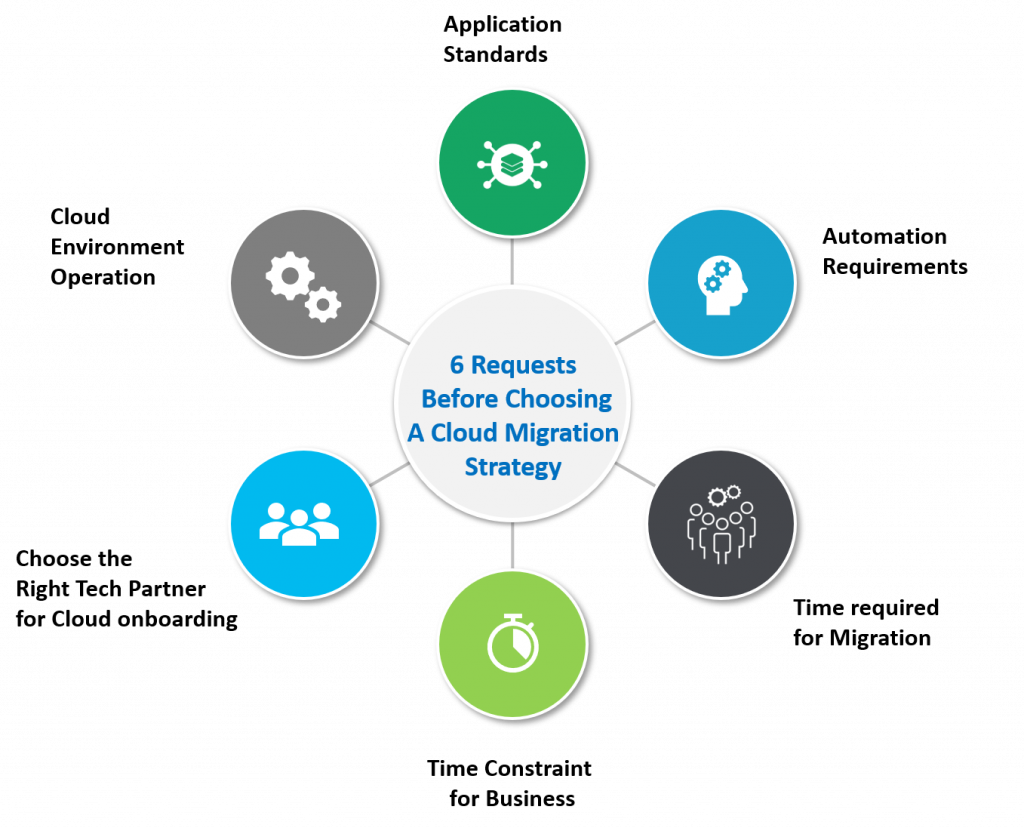



In the first part of the Cloud Migration Readiness blog series, we brought cloud technology trends, things to consider before you migrate your applications to the cloud, the essential infrastructure that must be measured. In this blog, we will bring the 6R Migration strategy, how to choose a migration strategy as per your enterprise scenario with a few use cases.
Migration Strategies
As per your business scenario, you have designed the setup where your cloud platform fits into the requirement with a well-aligned migration approach for supporting business cases. This sets a proper groundwork for enterprise cloud adoption that will lead to success. A cloud migration strategy is to collect application portfolio statistics and justify it into what it is mentioned as the 6Rs.
What is 6R Cloud Migration Strategy?
What is 6R Cloud Migration Strategy?
The 6R is a strategy to migrate applications to the cloud. This is a technique for classifying what is in your data center environment, the interdependencies, technical complications involved in migration, and the way your enterprise should go about migrating each application or set of applications. Using the “6R” framework outlined, you can group your applications into the following:

With this information proposal, the cloud migration plan can be prepared for each of the applications in your portfolio. This plan will be iterated on and will mature as you progress through the migration process, build confidence, learn new capabilities, and better understand your existing state. The difficulty of migrating current applications differs depending on reflections such as architecture, existing certifying contracts, and commercial requirements and these strategies will help build momentum.
Let us understand better each of the elements in the 6R Cloud Migration framework.
1. Re-host (“lift and shift”)
The re-host strategy is also known as lift and shift. Onboarding the applications on to cloud without any rapid changes from your datacenter tend to follow this approach. Businesses are demanding to move their applications quickly on the cloud and experience results by meeting their objectives. The majority of these applications are re-hosted to reduce the cost to achieve faster environment availability. In general, re-hosting can be automated with public cloud tools for easy migrations. Applications are easier to enhance/re-architect once they are available in the cloud. If you get a green signal from all your technical executives, your business can scale at a rapid pace.
2. Re-platform (“lift, tinker, and shift”)
The next strategy from the 6R Cloud Migration Framework is re-platform, also known as lift, tinker and shift. To achieve the migration benefit, re-platform requires a few modifications or optimization of the platform without changing the architecture level. As stated previously, the core architecture of the application will not be changed. To give an example, you can reduce the quantity of time you spend managing database instances by migrating to a database-as-a-service platform on the cloud.
3. Re-factor/Re-architect
Re-factor/re-architect is how the application is designed and developed using cloud-native features, which is driven by a sturdy business use case to add features, scalability and performance. If monolithic architecture is designed to move to serverless architecture to accelerate or improve business continuity, this strategy, although expensive, is the most beneficial one.
4. Re-purchase
Re-purchase is an approach to order new products, service, or offering to incorporate changes on the cloud architecture. This approach can be considered only if you are already on cloud space to transit substantial jobs or workloads.
5. Retire
Remove the applications or IT assets that are no longer needed, and it can be turned off without impacting your running business of the migration process. This can be achieved by discovering your environment that possesses each application. This strategy saves cost and directs your team’s attention to the applications folks to reduce the number of applications you must secure or halt.
6. Retain
Identify the required applications, resources and IT assets and plan to acquire those, one by one, to keep applications running, which are critical for the business. You can revisit all applications that fall in this category at a later point in time for any migration strategy.
Which strategy should I choose to migrate my enterprise data to the cloud?
Picking the right migration strategy will be subject to your business scenario for enterprise cloud adoption. Before you choose the migration strategy, make sure you address the six requests stated below:

To answer all the above questions or clarifications, enterprises can drive the migration timeline by retiring specific facilities and use savings to fund the transformation to cloud computing. You must consider any changes that can be executed quickly, safely while creating instant savings. Besides, enterprises can consider technology platforms that remove operational fences and allow them to scale this function.
Business continuity is a critical driver for your enterprise cloud migration strategy. You can take the time during the migration process to improve our position. Wherever application risk and costs are high, it is essential to consider a phased approach of migration first and optimize it in successive phases. In these scenarios, the migration plan must include the second phase, and for all custom development, enterprises can move to a DevOps model for complete automation of migration with an accelerated phase.
Next Stages
Examining your present state, the structure of the plan, and repeating the work, break down a large migration into manageable activities for well-organized execution. Use the Cloud Adoption Framework to examine your atmosphere through the different viewpoints to migrate to the cloud. With this effective migration strategy, experience a simplified journey to move all your applications to the cloud. Your business can implement, test, and validate changes faster with the cloud migration strategy. Besides, you will have the capability of driving migration in speed with agility.
Xoriant Cloud Capabilities
Xoriant’s cloud offerings span the entire spectrum of services from the application, data and analytics, infrastructure, security and DevOps. We have a cloud-specific solution IP and accelerators to enable your cloudification journey. Our high-level cloud migration strategy includes Enterprise Cloud Readiness Assessment framework, a 12-factor Application Assessment Checklist before pilot implementation.
Our cloud migration success stories range across a leading loan origination solution provider, a leading innovator in food safety and quality assurance, a large financial and brokerage firm, and one of the Big 4 Consulting Firms. With a strong technology proficiency across AWS Services, MS Azure, Google Cloud Platform, our team ensures a seamless cloud enablement journey for your enterprise.
Want to experience a seamless cloudification journey for your business, Xoriant experts can help you with your cloud enablement initiatives. Get in touch with us.
References
https://www.gartner.com/smarterwithgartner/4-trends-impacting-cloud-adoption-in-2020/
https://cloud.google.com/solutions/migration-to-gcp-getting-started



 View Previous Blog
View Previous Blog






